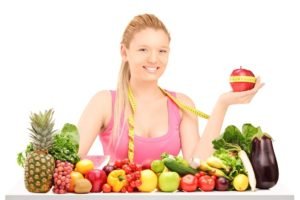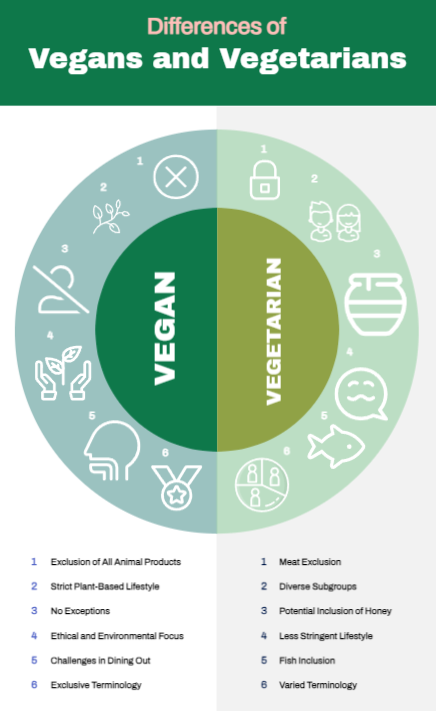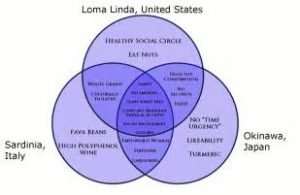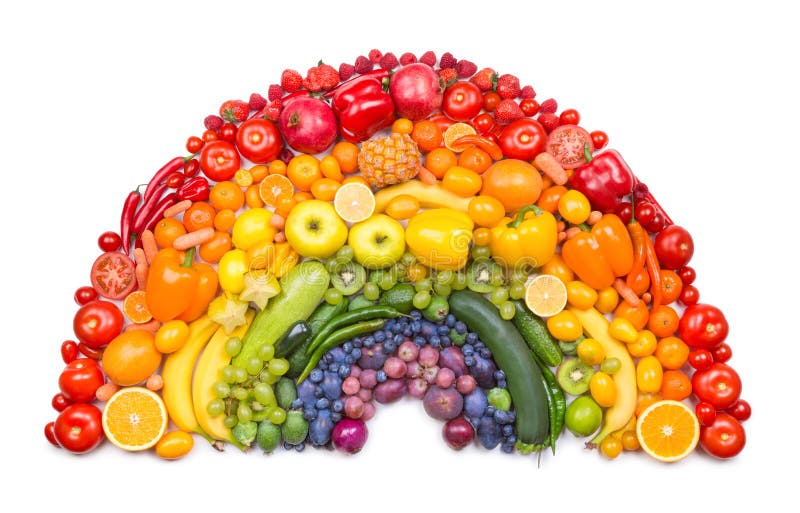Vegan Globetrotter is supported by our audience. When you purchase through one of our links, we may earn a small affiliate commission. As an Amazon Associate I earn from qualifying purchases. Your cost is not affected.
==================
Hey there, curious minds! If you’ve ever wondered about the differences between vegan and vegetarian diets, you’re in the right place. These two dietary lifestyles often get lumped together, but there are some distinct nuances that set them apart. So, let’s embark on a tasty journey through the world of plant-based eating and explore what makes vegans and vegetarians unique in their choices. Grab a snack, and let’s dig into the delicious details!
Vegan vs. Vegetarian, Is There a Difference?
Let’s dive into the fascinating world of plant-based diets, where the terms “vegan” and “vegetarian” often mingle, but their distinctions are quite interesting.

Veganism and vegetarianism are like two close cousins, sharing a commitment to plant-based eating, but they have their unique paths.
Vegans take it to the next level, embracing a lifestyle solely built on plant-based foods. They bid farewell to meats, yes, but they don’t stop there. Eggs, dairy, honey – all are out of the picture for vegans.
Vegetarians, on the other hand, might be seen as the more flexible cousins. They also skip meats, but here’s where the variety comes in. Some vegetarians welcome eggs, some embrace dairy, and others may even have a soft spot for honey. There are even specialized terms for these subgroups, like “Ovo-vegetarians” (those who include eggs) and “Lacto-vegetarians” (those who include dairy). If someone combines eggs and dairy, they might call themselves an “ova-lacto vegetarian” or stick with the classic “vegetarian” label.
Now, here’s where it gets intriguing. Some folks decide to let fish swim into their diet. They’re called “pesco-vegetarians.” While this inclusion might ruffle the feathers of purist vegetarians, pesco-vegetarians see it as a middle ground on the path to fully embracing the vegan lifestyle.

So, as you can see, the vegan vs. vegetarian debate isn’t just about labels; it’s about the diverse ways people choose to navigate the rich world of plant-based eating.

Why Choose a Plant-Based Diet?
Many pursue the vegetarian or vegan lifestyle as a means of protecting animal life. They feel that killing animals is inhumane. Many also disagree with factory farming practices that produce the majority of our non-vegetarian products.
 An increasing number of people practice the plant-based diet for health reasons. Studies show many health benefits to those choosing to forego meat and animal products. The China Study and other similar results led to Blue Zone Projects.
An increasing number of people practice the plant-based diet for health reasons. Studies show many health benefits to those choosing to forego meat and animal products. The China Study and other similar results led to Blue Zone Projects.
Not only do vegetarians live longer than meat eaters, they are healthier, on average. Some insurance companies consider this a factor when calculating insurance rates based on eating habits. Studies and statistics prove the many health benefits.
Loma Linda Study Results indicate vegans have a 15% lower risk of death than people on the standard American diet. Not only do they live longer, they enjoy better health and a reduced incidence of heart disease, cancer, and other illness.
Nutritional Considerations in Vegan and Vegetarian Diets
Sure, let’s chat about some important nutritional aspects to keep in mind when following vegan and vegetarian diets. These diets offer numerous health benefits but require a bit of attention to ensure you’re getting all the necessary nutrients. Here are some key nutritional considerations:
- Protein: Plant-based sources of protein are abundant and include foods like beans, lentils, tofu, tempeh, nuts, seeds, and whole grains. The key here is variety. By mixing up your protein sources, you can meet your protein needs easily.
- Vitamin B12: This essential nutrient is mainly found in animal products, so it’s crucial for vegans to consider fortified foods or B12 supplements to prevent deficiencies, which can lead to anemia and nerve issues.
- Iron: Plant-based iron is a bit different (non-heme) and is absorbed less efficiently than iron from animal sources (heme). Combine iron-rich foods like dark leafy greens, beans, lentils, and fortified cereals with vitamin C-rich foods like oranges or bell peppers to boost absorption.
- Calcium: Dairy is the primary source of calcium, but vegetarians can get it from dairy products. Vegans should opt for calcium-fortified plant-based milk, tofu, and leafy greens like kale or collard greens.
- Omega-3 Fatty Acids: These are essential for heart and brain health. Vegans can find them in flaxseeds, chia seeds, walnuts, and consider algae-based supplements. Vegetarians can also get them from omega-3 enriched eggs.
- Vitamin D: Essential for calcium absorption and bone health, vitamin D can be harder to come by in plant-based diets. Consider fortified foods or supplements if you get little sun exposure.
- Zinc: Nuts, seeds, legumes, and whole grains contain zinc, but it may be less bioavailable in plant-based diets. Adequate intake is vital for immune function and overall health.
- Iodine: It’s essential for thyroid function and can be found in iodized salt or iodine-rich seaweed for vegans.
- Fiber: Plant-based diets are usually high in fiber, which is great for digestion. However, if you’re not used to it, gradually introduce fiber to avoid tummy troubles.
- Vitamin A: Vegetarians can get vitamin A from dairy and eggs. Vegans can look to foods rich in beta-carotene, like carrots, sweet potatoes, and spinach.
- Vitamin K2: Found mainly in animal products, you can source vitamin K2 from fermented foods like natto or supplements if you prefer a plant-based diet.
- Balanced Diet: To cover all your bases, aim for a balanced diet with a variety of fruits, vegetables, whole grains, legumes, and plant-based proteins. The more colorful your plate, the better!
Chatting with a registered dietitian or nutritionist is always a good idea when starting a vegan or vegetarian diet. They can help you create a personalized meal plan that ensures you get all the nutrients you need for overall health and well-being. And if you have any concerns, regular blood tests can help monitor your nutrient levels.

Health Benefits for Part-Timers, Too

Jumping from eating standard meat-eating fare into a vegan diet seems extreme to many. It does take time to retrain your taste buds and become accustomed to the textures and flavors.
Meatless Monday began in 2003 to allow people to try the plant-based lifestyle. While no one expects dramatic health effects by making the change one day a week, it can lead to healthier food choices. For some people, this little step offers a chance to try a healthier diet without feeling trapped.
Many begin their health journey by eliminating red meats, then chicken and eventually become vegetarian. The next jump to entirely plant-based might prove more challenging, especially for those relying heavily on dairy and eggs.
Taking the Plunge
The choice to adopt a plant-based lifestyle often comes from a significant health issue. Diabetes, heart disease, and other critical medical concerns often jar people into considering eating healthier and exercising. For these people, as well as others, Meatless Monday is not enough. An immediate change to a vegan diet might well save their life and start them on the road to health.
For those that choose to plunge in, rather than testing the water, many opt for convenience substitutes, at least to start. Vegetarian burgers, sausage, and even turkey cutlets offer great taste and texture without the meat. Many find that they are preferable. Senior citizens, for instance, may have problems chewing and digesting meats. However, a pot roast made from vegan beef tips offers the taste and delicate texture in an easy-to-chew form. Other recipes also help the transition.
While some stay with these vegan meat substitutes, many use them as a transition. Often expensive and containing some ingredients considered less healthy, the substitutes provide one route to transition to the best diet. Consider balancing these with healthier options and eventually eliminating them.

Transitioning to Plant-Based Diets: Making the Shift Delicious and Easy
Embarking on a plant-based diet journey is exciting but challenging if you’re accustomed to a meat-heavy menu. Fear not; we’re here to guide you through the transition, making it delicious and achievable.
1. Start Slowly: Going vegan or vegetarian overnight might feel daunting. So, why not take gradual steps? Begin by designating one or more days a week as “Meatless Days.” You can experiment with new plant-based recipes on these days while still enjoying your favorite non-veg meals on others.
2. Explore Plant-Based Proteins: Replace meat with plant-based protein sources like tofu, tempeh, beans, lentils, and chickpeas. These ingredients are not only rich in protein but also offer a variety of flavors and textures to keep your taste buds entertained.
3. Experiment with Meat Substitutes: Today, the market is brimming with meat substitutes that closely mimic the taste and texture of meat. Veggie burgers, sausages, and even “chicken” nuggets can be a fun way to transition without giving up familiar flavors.
4. Embrace Whole Foods: While meat substitutes can be handy, don’t forget to focus on whole, unprocessed foods. Fresh fruits, vegetables, whole grains, and nuts should form the foundation of your plant-based diet.
5. Get Creative in the Kitchen: Plant-based cooking opens up a world of culinary creativity. Experiment with different cuisines, spices, and cooking methods to discover new, delicious dishes. Pinterest and vegan cookbooks are excellent sources of inspiration.
6. Educate Yourself: Understanding the nutritional aspects of your new diet is vital. Learn about essential nutrients, such as protein, iron, calcium, and B12, and where to find them in plant-based foods. This knowledge will empower you to make informed food choices.
7. Plan Balanced Meals: Aim for balanced meals that include a variety of foods. For example, pair beans or lentils (protein) with grains like quinoa (fiber and protein) and plenty of colorful vegetables (vitamins and minerals).
8. Read Labels: When shopping, read food labels carefully. Some processed foods may contain hidden animal-derived ingredients. Look for certified vegan or vegetarian labels to make your shopping easier.
9. Connect with a Community: Joining vegan or vegetarian communities, both online and offline, can provide you with support, recipe ideas, and a sense of belonging. It’s a great way to share your journey and seek advice.
10. Be Patient: Finally, be patient with yourself. Transitioning to a plant-based diet is a lifestyle change, and it’s perfectly normal to have moments where you miss your old favorites. Don’t be too hard on yourself; it’s all part of the journey.
Remember, there’s no one-size-fits-all approach to transitioning to a plant-based diet. It’s about finding what works best for you and your preferences. With time, you’ll discover a wide array of delicious plant-based meals that make you wonder why you didn’t make the switch sooner. Enjoy your plant-based adventure!
Starting Now or Already on the Journey…
Whether just trying occasional meals or celebrating decades of plant-based eating, new recipes, and exciting cuisine offer more choices for healthy foods. While many countries and regions within countries have unique cuisines, America offers choices from all over the world. Indeed, each region often features local favorites, while most cities offer an even greater variety. Our melting pot design encourages newcomers to bring the best from their birth country. We integrate those favorites into our own.
Vegan Globetrotters allows you to virtually travel around America and around the globe virtually, choosing healthy vegan options to add to your family favorites. And like any adventure, the journey is never over. We’ll continue to add new flavors, new inspirations, and interesting features. Stop by often!
Frequently Asked Questions
What's the difference between vegan and vegetarian diets?
In a nutshell, vegans skip all animal products, including meat, eggs, dairy, and honey, while vegetarians might include some of these in their diet, depending on their preferences (like eggs or dairy). It’s a nuanced world of plant-based eating!
How can I get enough protein on a vegan diet?
You’ve got options! Plant-based protein sources like beans, lentils, tofu, nuts, and seeds are your new best friends. They’re not only delicious but also packed with the good stuff.
Is it hard to find vegan-friendly restaurants while traveling?
It used to be tricky, but not anymore! Vegan options are popping up everywhere. With some research and helpful apps, you can globetrot and dine like a plant-based pro.
Join the Vegan Community! Discover, Connect, and Explore with Us! 🌱
👉 Facebook: Dive into engaging content, join discussions, and get the latest product reviews in the world of veganism.
📸 Instagram: Explore the vibrant and mouthwatering visuals of vegan cuisine and connect with fellow globetrotting vegans.
📌 Pinterest: Pin your favorite vegan recipes and travel inspirations while discovering new ideas for your plant-based journey.
🐦 Twitter: Stay updated with the latest news, trends, and community buzz in the vegan world.
Join us on these platforms and be part of a passionate vegan community. Together, we’re making the world a more delicious and compassionate place, one plant-based adventure at a time! 🌍🌱 #VeganGlobetrotter




Don't miss out
when new recipes and information are added!
Join our newsletter for free recipes,
healthy living inspiration, and special offers
You have Successfully Subscribed!